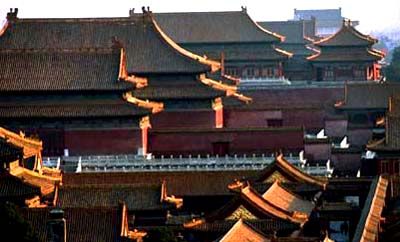http://www.dpm.org.cn/
 |
The Palace Museum, historically and artistically one of the most comprehensive museum in China, was established on the basis of the Forbidden City, a palace of the Ming and Qing dynasties (1368-1840), and their collection of treasures.
-- History
Located in the center of Beijing, the Forbidden City used to be the imperial palace of the Ming and Qing dynasties. It is nearly 600 years old, with construction started in 1406 and completed in 1420. The principles ofFeng Shui, the ancient Chinese system of geomancy, governed the whole process. The rectangular palace covers an area of some 720,000 sq. km -- 961 m in length and 760 m in width. It has a total of 9999.5 room spaces (an area enclosed by four poles). In 1924, the imperial family of the Qing Dynasty (1644-1840) was removed from the Forbidden City, and in 1925 the Palace Museum was established here.
Emperors of the Ming and Qing dynasties from 1420 to 1911 held court and lived within the walls of the Forbidden City. After the republican revolution, this palace as a whole would have been sequestered by the Nationalist government were it not for the "Articles of Favorable Treatment of the Qing House" which allowed Puyi to live on in the Inner Court after his abdication. Meanwhile, all the imperial treasures from palaces in Rehe (today's Chengde) and Mukden (today's Shenyang) were moved to the Forbidden City for public display in an antiquities museum established at the Outer Court in 1914. While confined to the Inner Court, Puyi continuously used such vestiges of influence as still remained to plot his own restoration. He also systematically stole or pawned a huge number of cultural relics under the pretext of granting them as rewards to his courtiers and minions or taking them out for repair.
In 1924, during a coup launched by the warlord Feng Yuxiang, Puyi was expelled from the Forbidden City and the management of the palace fell to the charge of a committee set up to deal with the concerns of the deposed imperial family. The committee began a sorting and counting of the imperial treasures. After a year of intense preparations, its members arranged a grand ceremony on October 10, 1925 in front of the Palace of Heavenly Purity to mark the inception of the Palace Museum. News of the opening flashed across the nation, and such was the scramble of visitors on the first day that traffic jams around Beijing brought the city almost to a standstill.
According to a 28-volume inventory published in 1925, the treasure trove left by the Qing numbered more than 1.17 million items.
Shortly before the outbreak of World War II, the Japanese, having annexed territory in China's northeast, proceeded to march on Beijing. With this looming crisis, the museum authorities decided to evacuate its collection rather than let it fall into enemy's hands or risk destruction in battle. For four frantic months between February and May 1933, the most important pieces in the collection were packed into 13,427 crates and 64 bundles and sent to Shanghai in five batches. From there they were dispatched to Nanjing where a depository was built and a branch of the Palace Museum established.